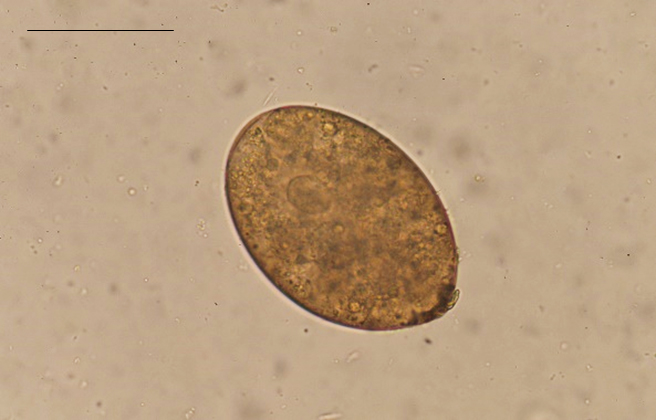Intestinal Flukes
Intestinal flukes are food-borne digenean trematodes that can infect a wide range of definitive hosts, including cats. They are zoonotic.
Distribution
Echinochasmus perfoliatus is present in Europe, Middle and the Far East. Pharyngostomum cordatum is found in cats in Europe, Africa and China. Echinochasmus japonicus, Echinostoma spp. and Haplorchis yokogawai are present in Asia. Haplorchis taichui is found in the Middle East and Asia. Stellantchasmus falcatus has been reported from the Middle East, Asia, and Hawaii. Heterophyes heterophyes has been reported in the Middle East, Mediterranean, India and Japan. Metagonimus yokogawai has been reported in Asia, Spain and the Balkans. [1,2,3]
Clinical signs
Most intestinal fluke infections in cats are asymptomatic. Pharyngostomum cordatum can cause chronic diarrhoea. Heavy infections by M. yokogawai are likely to cause small-bowel diarrhoea [1].

Figure 1. Echinostoma egg on faecal sedimenation (Image credit: Shutterstock)
Diagnosis
Intestinal fluke infections can be confirmed by faecal sedimentation (SOP 4). Eggs are large, oval, tan and operculate (Fig. 1)and approximately 90-135 x 55-95 μm for E. perfoliatus, 100 x 70 μm for P. cordatum and 83-120 x 58-90 μm for Echinostoma spp. Heterophyidae adults are minute (1-2 mm) and their eggs are smaller with a distinct shoulder below the operculum and 29-30 x 13-17 μm for H. yokogawai, 24-28 x 12-15 μm for H. taichui, 21-23 x 12-13 μm for S. falcatus, 27 x 16 μm for H. heterophyes and 26-28 x 15-17 μm for M. yokogawai and cannot be easily distinguished from those of feline liver fluke eggs [1].
Treatment
Off-label use of praziquantel at 30 mg/kg SC was effective in eliminating eggs from the faeces of infected cats and resolving signs of diarrhoea caused by P. cordatum [1].
Prevention and Control
The control of intestinal fluke infections can be achieved by preventing cats from ingesting raw fish, and from hunting and ingesting other intermediate hosts.
Public health considerations
Many species of intestinal flukes that infect cats have been reported in humans [1]. Cats may act as a zoonotic reservoir for human infection in communities where fish-borne trematode zoonoses is endemic.
References
[1] Bowman DD, Hendrix CM, Lindsay DS, Barr SC. Feline Clinical Parasitology. Iowa State University Press, Ames, USA. 2002.
[2] El-Azazy OM, Abdou NE, Khalil AI, Al-Batel MK, Majeed QA, Henedi AA, Tahrani LM. Potential Zoonotic Trematodes Recovered in Stray Cats from Kuwait Municipality, Kuwait. Korean J Parasitol. 2015;53:279-287.
[3] Khalil MI, El-Shahawy IS, Abdelkader HS. Studies on some fish parasites of public health importance in the southern area of Saudi Arabia. Rev Bras Parasitol Vet. 2014;23:435-442.
